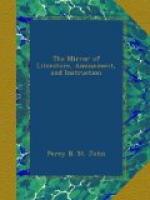[4] Tour on the Continent.
The last mentioned species is the supposed idol of the Hottentots; the person on whom the adored insect happens to light, being considered as favoured by the distinction of a celestial visitant, and regarded ever after as a saint.
* * * * *
2. Branched starfish.
This is the most curious species of Asterias, or Sea Star. They are crustaceous animals, and many of the species are noxious to oysters, others to cod-fish, &c.
The species represented by the Cut, has five rays, dividing into innumerable lines or branches. The mouth is in the centre, armed with sharp teeth, which convey the food into the body, and from this mouth goes a separate canal through the rays. These the animal, in swimming, spreads like a net to their full length; and when it perceives any prey within them, draws them in again with all the dexterity of a fisherman. It is an inhabitant of every sea; and is called by some the Magellanic starfish and basketfish. When it extends its rays fully, it forms a circle of nearly three feet in diameter; and Blumenbach tells us that 82,000 extremities have been reckoned in one of these curious creatures.
In another species of the Asterias, the power of reproduction is particularly-striking. “I possess one,” says Blumenbach, “in which regeneration had begun of the 4 rays that had been removed out of 5 which it originally possessed.” We have picked up on the seashore many of the species to which he alludes, and they are much less rare than that in the Cut. Of the latter we have seen three or four specimens—one in a small Museum at Margate, and, we think, two others in the Museum in the Jardin des Plantes, at Paris. They resemble a bunch or knot of dark brown small rope or cord.
There is a popular idea among the Norwegians, that this animal is the young of the famous Kraken, of which Pontoppidan has related so many wonders.[5] This monster, it will be recollected, is supposed to live in the depths of the sea, rising occasionally, to the great danger of the ships with which it comes in contact, at which times the projection of its back above the surface of the sea, resembles a floating island.




